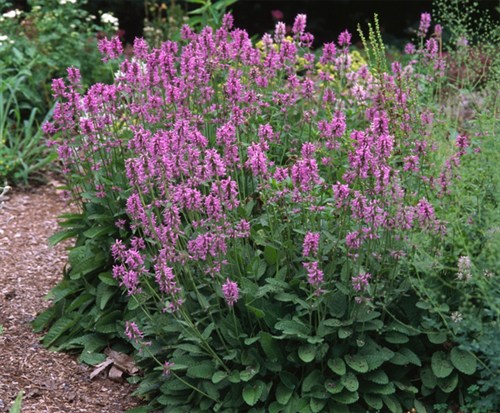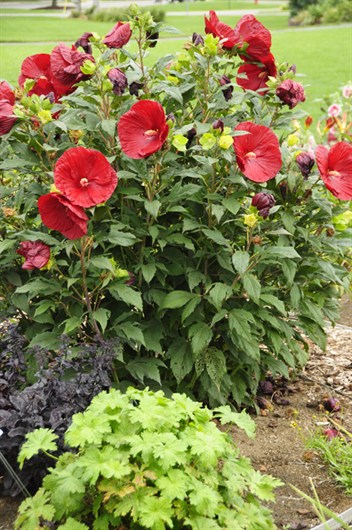Even the best perennial may have down time
It's your choice to ignore that, or remove spent flowers and
cut back
Even the neatest, longest-blooming, most dependable repeat
bloomers in the perennial world can use attention now and then to
look their best. The perennials we've listed as "Easiest
Best" are in this category.
You may ignore these plants' shortcomings in order to enjoy the
least possible maintenance. Alternatively, you can deadhead during
the bloom season -- clip off spent flowers as they develop, to keep
new blooms coming -- and cut back when bloom finishes.
As you decide which course to take, do not imagine that you must
work with bent back and floral scissors to deadhead and cut back.
Such cuts can be made with mowers and weed whips (string
trimmers).
As examples:
Benefit from deadhead/cut back: Big betony (Stachys
micrantha)
Need time to grow: Coral bells
(Heuchera hybrid 'Caramel')
May have distracting brown spent flowers: Hardy Hibiscus
Can do with
a cut-back: Big betony
Big betony (Stachys micrantha) is one of the best of
the best perennials, good for

the front row because its bloom season is long, it is very
willing to rebloom if deadheaded, and it is not terribly unsightly
during its down time even if untended.
Here's a no-gloss look at its appearance through the year, and
the difference it can make if the plant has some minimal
attention.
Big betony from first bloom to first brown
Right: 18" tall in bloom. White, lilac and violet varieties
(violet shown here) are available. Here, about a week into what is
normally a 5 week bloom period.
Here is a group of big betony in bloom in June (below, left)
and then eight weeks later when all blooms are spent and new
flowers have finally stopped forming. In the interim, the plants
were deadheaded once, extending their bloom by 2-3 weeks. Now, the
plants can be left as is, or cut back to refresh their
foliage. If cut back they may also provide a bit more bloom in
September.


Note: The cutting back can be done with scissors, one spent stem
at a time. It can also be done with shears or a mower, a rougher
cut that removes both old leaves and new, thus leaving a temporary
gap -- the plants will regenerate.
Big betony in the fall
Now take a look at big betony at the very end of the growing
season. The photo below was taken in late October, after frosts
have occurred that ended annual plants' year but before the killing
frost that will stop perennial growth.
There are ten big betony plants here. Most have dry seed stalks
showing above the foliage, and still bear the somewhat tattered
leaves that are part of those stems. These plants bloomed, were
enjoyed for that color, but left "au naturel." What you see there
are big betony plants grown at the lowest possible care level.
One plant (arrow) was cut back after its first bloom. Its place
was relatively bare for about two weeks after the cut, but since
then it has had all new foliage. This is a best, easiest perennial
with just a bit of extra attention.
Despite the varied treatment, all of the plants in this group
will be back in equal health and bloom next year.
 As a related aside: The lush light green mounds in
the background are bigroot perennial geranium (G.
macrorrhizum), another "best, easiest" perennial. It's one of
that group which does not need even the minimal extra attention
just described for big betony to remain looking so fresh. However,
there is always a trade-off: Its bloom season is not so long as big
betony's.
As a related aside: The lush light green mounds in
the background are bigroot perennial geranium (G.
macrorrhizum), another "best, easiest" perennial. It's one of
that group which does not need even the minimal extra attention
just described for big betony to remain looking so fresh. However,
there is always a trade-off: Its bloom season is not so long as big
betony's.
Example 2: Coral bells
demonstrate the wait-a-year clause
The best perennials are long lived and not aggressive. You can
expect them to be contributing members of your landscape for a long
time, without becoming pests through overgrowth.
However, these plants can't be rushed. Plant them with enough
space to grow healthy, and wait.
Here's Heuchera 'Caramel' its first year.

Below: At the beginning of year two, those same plants have
filled in.

If we want to crowd them, we have to remove some plants by the
end of the first summer so the rest can grow healthy into
maturity.
Example 3:
Hardy Hibiscus shows us peak- vs. late bloom
Two points: First, that even a long-blooming perennial has a
peak bloom time when it is most likely to look like its catalogue
photo. Second: Intervention can improve even the most gloriously
blooming plant.
We use Hibiscus as an example because the bigger
the flower, the bigger the spent bloom. Hardy Hibiscus has
huge blooms. Each lasts one day and then separates from the
stem.... but it may lodge among the leaves and become
unsightly.
Deadheading these plants can keep the color show pure, and may
extend the bloom period. That happens because younger and lower
stems may be encouraged to keep growing if no seed begins to form
on the first flower stalks. Those younger stems can produce another
flush of flower buds.

Right: See the spent flower hanging on this Hibiscus
'Summer Storm'? Between those brown petals and the
flower that's just opening are three more flower buds. Those
flowers can look more impressive on a clean stage. You can do the
clean up by simply knocking down dead petals.
Alternatively, you can deadhead. That is, snap off or clip
off brown petals along with the green pod that produced them. Do
this one flower at a time, or wait until all five flowers on this
stem have finished and then cut that stem back to a clean
leaf. Deadheading removes the seed-producing structures
and can encourage flowers to keep forming on lower stems for a
longer overall bloom time.
Note: Hardy Hibiscus does not change its following year
performance if deadheaded. It will be healthy and free blooming in
future years regardless of your choice in treatment.
That's the detailed look.
Below, the bigger picture.
Now, for the overall look of Hibiscus in bloom,
comparing peak bloom to end bloom, and giving you a look at
pristine flowers sharing the stage with some hanger-on brown
petals.
Below, left, Hibiscus 'Cranberry Crush' at its
prime. (Thanks and photo copyright to PerennialResource.com, the very fine consumer
information service of one of the world's largest and finest
perennial growers.) Below, right, Steven Nikkila's photo of the
same plant from its far side and a little later into its bloom
period.


Below, left, Hibiscus 'Summer Storm' at its prime.
(Thanks and photo copyright to PerennialResource.com, the very fine consumer
information service of one of the world's largest and finest
perennial growers.) Below, right, Steven Nikkila's photo of the
same plant a few weeks later into its bloom period.

